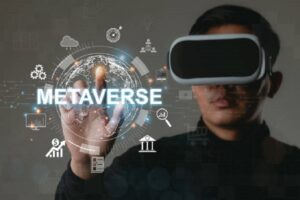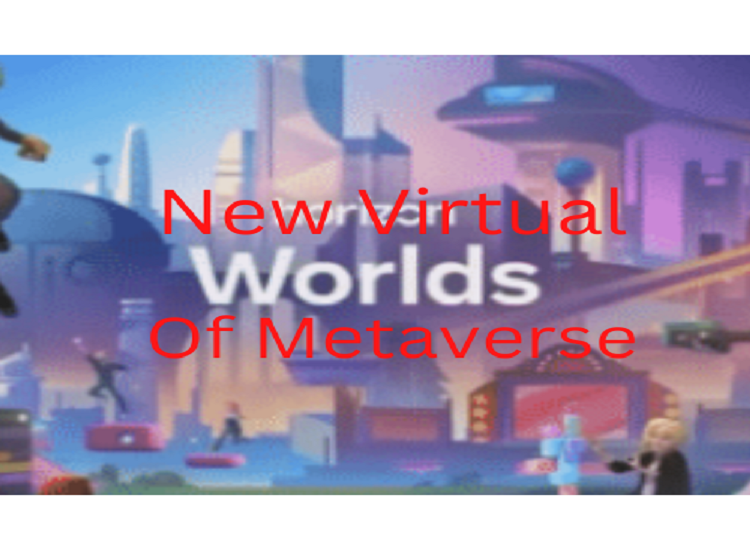The metaverse concept has been around since the 80s but has recently gained more traction among projects emerging on the scene. It will likely influence our lives and how we do business in so many ways, some of which are currently not easy to understand. Many people are still ignorant of this new world of technology. Apple CEO, Tim Cook, in an interview with Dutch Media Bright stated that an average person doesn’t understand what metaverse is.
In this article, you will learn the basic things about the metaverse, though this topic is vast and cannot be fully discussed in a single article. In subsequent articles, we will be able to discuss it fully to inform and educate our audience.
What is Metaverse?
Imagine a virtual world where people can live, work, shop, and interact with others from the comfort of their homes in the physical world.
Metaverse is a technology that combines multiple elements which include virtual reality, augmented reality, and videos, a mixed-reality world that can be accessed through a browser or headset to enable people to have real-time interaction and experience across distance. Experts see it as a 3D model of the internet, a place parallel to the physical world. This embodied internet enables people around the world to meet by creating avatars that can be personalized and make them look more non-fictional than a normal video call.
Origin of Metaverse
The metaverse idea started back in 1838 when scientist Sir Charles Wheatstone discovered the concept of “Binocular Vision,” where you can combine two images, one for each eye, to make a single 3D image. This concept led to the development of stereoscopes, a technology that enables you to create an image using the illusion of depth. This same concept is used today in modern VR headsets.
The term Metaverse was first used by author Neal Stephenson when it was coined in his science fiction novel, Snow Crash, in 1992, where humans interact with each other and software agents as programmable avatars in a three-dimensional virtual space that uses symbols of the real world. In his novel, Stephenson envisioned lifelike avatars who met 3D buildings and other virtual reality environments. The characters could go to a virtual place to escape a dreary totalitarian reality.
In the 1990s, Sega introduced VR arcade machines like the SEGA VR-1 motion simulator, which is used in many arcades.
In 1998, Sportsvision introduced the first live NFL game with a yellow marker. Thereafter, the idea of overlaying graphics over real-world vision spread to other sports broadcasting.
In 2010, Palmer Luckey, an 18-year-old entrepreneur, and inventor created the prototype for the Oculus Rift VR headset. The revolutionary headset brought back interest in VR with its 90-degree field of vision and use of computer processing power.
What gave another peek inside this whole new world that enables us to escape from reality, is the book, Ready Player One, released by Ernest Cline in 2011. This became a runaway hit with director Stephen Spielberg making it into a movie in 2018.
In 2014, Facebook acquired Oculus in a $2 billion deal, founder Mark Zuckerberg stated that the duo would work together to build the Oculus platform, and develop a stronger partnership to support more games.
In the same year, Sony and Samsung announced they were creating their own VR headsets. Google released its Cardboard device and Google Glass AR glasses. The device is a low-cost cardboard AR viewer for smartphones.
Microsoft released its Hololens headset into the market in 2016 introducing mixed reality (AR and VR) for the first time. This device enables users to create a holographic image in front of them, put it into the real world, and manipulate it using augmented reality. Another one that stirred people’s interest in the same year is Pokemon, which enables the Pokemon GO augmented reality game.
The Swedish furniture giant IKEA came into the Metaverse mix in 2017 with their Place app that allows users to select a piece of furniture and view what it’s like in their homes or offices.
Apple paved the way for mixed reality headsets by adding Lidar (Light Detection and Ranging) to iPhones and iPads providing better scanning for better photos and AR. According to reports, Apple is currently working on possible ways virtual and augmented reality could be implemented into future iOS devices or new hardware products. The new device could replace our smartphones as an interface into the Metaverse of the future.
Facebook changed its name to Meta, indicating its focus on shaping the future of Metaverse. We have witnessed an increasing interest in this new world of business and fun since the social media giant came on board.
How Does Metaverse Work?
The current set of metaverse worlds each has its own access, avatars, interactions, and currency. Decentraland for example uses MANA, which is separate from Sandbox sand which uses SAND as its currency and Ariva Wonderland uses ARV coin. Blockchain technology makes it possible to define a virtual thing so it can be bought and sold. There are different metaverse worlds, Decentraland, Sandbox, and Ariva Wonderland for example are metaverse worlds that sell land to businesses that build virtual things. Sotheby’s 300-year-old auction house has a building in Decentraland where your avatar can walk around and view what is being auctioned. Republic Realm, a company that develops land on the metaverse recently bought a land space on Sandbox for $4.3 million.
Paying huge money to get virtual land may sound crazy right now but some years ago most of us thought purchasing Bitcoin was crazy, recently it wasn’t crazy people became millionaires just by spending a few hundred dollars buying Bitcoin at the early stage.
Elements of Metaverse
All the elements of the metaverse are interconnected, and they work together to form a new world of realities. These may include:
- Cryptocurrency
- Concerts, Social and Entertainment Events
- Market Place/Digital Commerce
- Online Shopping
- Nonfungible Tokens (NFTS)
- Workplace
- Device Independence
- Social Media
- Gaming
- Digital Humans or Avatars
- Digital Assets
- Natural Language Processing
Major Components of Metaverse?
The Metaverse will be a living consistent experience for all its users in real time. Any person from any corner of the globe can access the open metaverse and participate in its activities as an individual or a team. Below are the core components that will function together to form the metaverse.
1. Virtual Worlds, Games, and Communities

We have noticed a rising interest in the virtual worlds during and after the pandemic. More people find social comfort in their game-like environment to fill up the connection gaps in the real world. Experts think that virtual worlds are the next big thing in social media platforms. This explains why tech giants such as Meta and Microsoft are taking actionable steps into virtual world-building.
Big names like Minecraft, Roblox, and Fortnite have the most organized virtual worlds, more startups are investing in next-generation-complex digital societies that are not game related. Second Life has built a functional virtual world since 2003 with a dedicated and royal resident community.
Communities are a very important part of virtual world-building. Second Life is a prove that metaverse should be in the hands of the community to ensure sustainable growth.
2. Virtual and Augmented Reality
Virtual and augmented reality (VR and AR) are developing technologies that connect the virtual worlds with a 3D experience. VR and AR are special computing programs that create a stimulating environment via computer technology.
Virtual reality is recognized by the head-mounted display (HMD), a software that teleports users to a virtual world, and they are occupied and can commune with the 3D worlds. VR creates a virtual environment through gloves, sensors, and VR headsets infusing functional visual elements into digital world creation. It will in the future enable users to have physical stimulations via VR technology and equipment.
For example, video games that use VR can give their gamers an immersive perspective of the activities via headsets such as HTC Vive, or Oculus Rift. The use of VR headsets in gaming has brought an increase in VR market revenue as VR device demand grows due to its use in the virtual world.
The market was valued at $21.83 billion in 2021 and is expected to expand at a compound annual growth rate (CAGR) of 15.0% from 2022 to 2030.
Augmented Reality: This is different from virtual reality, it stimulates the unnatural objects in the environment using sensors and algorithms to regulate and direct the position of the spot and arrange the movement of the camera. It uses smart devices to augment the real-world experience by placing 3D images into a digital device’s screen to make it appear as if the digital object is in the same place as the observer.
Big tech companies such as Google and Microsoft are creating 3D communication devices that can turn users into life-size holograms. For instance, Google Project. Startline allows users to experience life-size 3D hologram face-to-face chats.
3. Artificial Inteligence

The metaverse experience can be made more realistic with AI-generated user avatars that resemble the users. In the future, AI-generated digital humans could populate the digital world offering various services such as personal assistance and language translation. In the metaverse, AI could be used to generate hyper-personalized experiences, smart contract support, networking as well as support the safety and inclusion of all people.
4. 3D Reconstruction
This is the process of capturing the shape and appearance of real objects in computer vision, enabling an object to be recreated. The mixed, virtual, and augmented reality in the metaverse requires 3D content. These 3D content creation tools are metaverse tools that support extended reality. Unity Software and Unreal Engine are examples of 3D reconstruction platforms.
5. Internet of Everything (IoE)
The Internet of Everything (IoE) is the intelligent connection bringing together people, processes, data, and things to make networked connections more relevant and valuable. Device connectivity enables the metaverse to function, the IoE connects data, people, devices, and processes via private and public networks. It feeds the metaverse with data and supports interactions between users. It can reduce the level of device reliance on virtual assistants and voice commands.
6. Blockchain Technology
Blockchain was used to establish the decentralized network of virtual worlds and 3D spaces known as the metaverse, it works together with AR and VR, and other technologies to bring the metaverse from conception to reality. Blockchain is the technology that enables users to protect their digital assets in virtual reality. This makes it very vital for developing an ecosystem in the metaverse where one can own, create and monetize the decentralized assets.
In the future, the metaverse would become an open, interconnected decentralized virtual world, each with its native functioning economy. Blockchain technology will support secure and private value transfer, immutable data storage, and payment rails that permit the free flow of value in a borderless space via digital currency.
The blockchain will also provide the uniqueness and originality of the digital assets and identify them through the non-fungible token (NFTs) technology. Digital avatar NFTs are currently selling more than other NFTs.
Why You Should Have Your Business on Metaverse
There is an increasing interest in the metaverse driven by the ability to own virtual objects, experiences, and land fully. The blockchain makes it possible to create and sell virtual things on the new world platform. If your business is catering to young and middle-aged adults you can easily reach them on this new platform.
Nikeland, a place to hang out on the metaverse, play, and dress your avatar in virtual Nike products, opened in Roblox in 2021. According to a report, 7 million people visited Nikeland early this year. A virtual concert hosted in Fortnite by rapper Travis Scott in 2020 had 12.3 million people in attendance. The video showed real people connecting from different locations around the world.
As a business, there are things you can do in virtual reality and augmented reality that you can’t do in real life across distance.
- Having a team meeting is more real than having it on zoom, you can point to something to explain, use hand gestures, or draw on a piece of paper.
- You can travel or go places together.
- Metaverse makes it easy for teams to collaborate and work on new ideas, eliminating the impediment of distance.
- Meetings and collaborative activities feel like being together in one room
- It creates a real connection and builds a social bond
Any organization can have a virtual meeting that is second best to in personal gathering. A team can have a work break during meetings or collaborative activities, to play virtual games with other colleagues from different locations in the world as a virtual equivalent of an office coffee break.
Brands will be able to add another level of interaction to their business by creating communities in the metaverse and growing their fan bases.
How do Businesses Get Started?
Creating value through the Metaverse is one of the tools available for organizations to meet their strategic needs. To get started, businesses could focus on leveraging this new world of technology by identifying the most suitable Metaverse categories suitable for them,
Customer Facing: Businesses need to deliver experiences that engage their audience and go in line with their brand. You need to be in this category if your business caters to young adults and if your target market is 15-30 years of age. Some of the services you could provide include building a storefront that sells virtual goods and connecting to your eCommerce offerings. You can also deliver events or other engagements.
Employee Facing: This technology is perfect for building community, and affiliation, organization can have better engagement, hybrid meetings, multi-location training, and institutional events. It is also the best tool for organizations to bring their tools together from across the globe.
Internal Operations: Businesses can save cost by using this technology to explore industrial and operational scenario which is more expensive in the real life. An example is auto companies designing in ‘Digital Twins’ doing their first dummy crash test in a Metaverse, Collaborating on model modification in augmented reality.
Think through where you can find value in each of the three categories before doing Metaverse.
What Will be the Future of Metaverse?
Metaverse is now a gamified world with limited integration and engagement capabilities, available for early adopters to test and enjoy the concept. To advance in the future in the world of the metaverse and bridge the gap between the physical and the digital worlds, we must be ready to push the boundaries beyond what we currently consider a metaverse.
The metaverse could have more commercial activity and greater reach than the current web, considering the rate at which businesses and giant tech companies are gravitating toward the virtual world. It will change the monetization of modern resources as well, work from home jobs will be on the increase with a higher value wage distributed in its borderless economy.
Conclusion
Metaverse has an assemblage of services bound to one another which makes it a network, not a solitary service. It brings different concepts together and attempts to explain their connection offering a perfectly functional economy. Metaverse will change the way people connect, businesses grow and creators make a living and bring a better social experience than any social platform. When users log out or leave the metaverse, they don’t have to start from scratch the next time.
This whole new world of the metaverse is the future of the internet, it will help take learning and discovery to a different level. Though it’s virtual, the impact and experience are real, people will be able to learn by doing not just by absorbing information, diving into new topics and experiences, and increasing knowledge through 3D immersion.
Join us in promoting Metaverse, and spread the word with our customized products, click here
Support this publication to deliver more educational and informative content, click here



